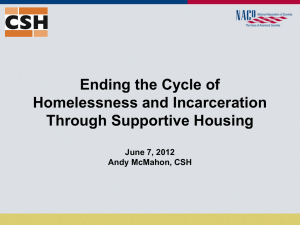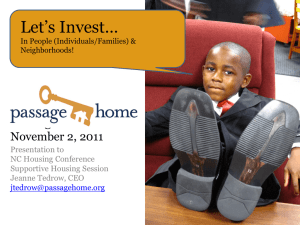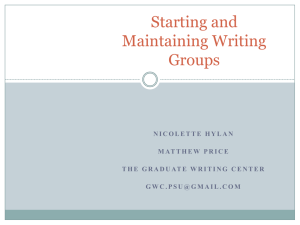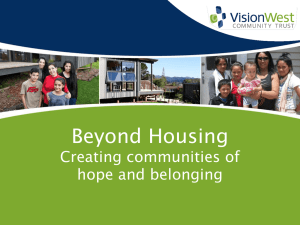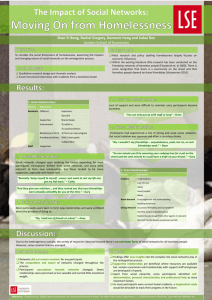Supportive Housing: A Tool for Re-entry Planning
advertisement
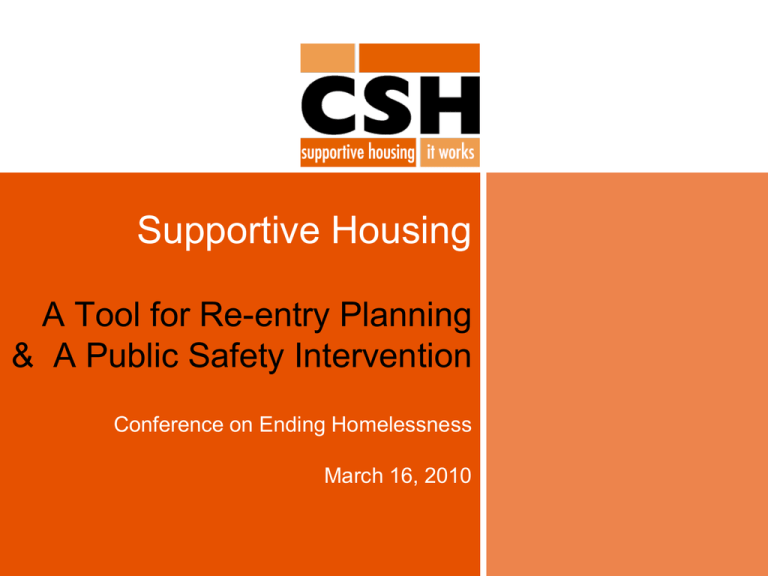
Supportive Housing A Tool for Re-entry Planning & A Public Safety Intervention Conference on Ending Homelessness March 16, 2010 Outline Overview of CSH and Supportive Housing Intersection between Incarceration, Homelessness Returning Home Initiative On the Ground Examples Corporation for Supportive Housing Our Mission CSH helps communities create permanent housing with services to prevent and end homelessness. CSH Products and Services Program and system design Program implementation Project specific technical assistance Financial products, including lending and grant making Policy design, reform and systems change Research / evaluation design and guidance Training and capacity building Resource tools Accomplishments Since inception in 1991, CSH has: Raised over $221 million from foundations, corporations, and government contracts to expand supportive housing nationwide. Leveraged $6.15 billion in federal, state, and local public and private sector financing. Committed over $200 million in targeted technical assistance, loans and grants to support the creation of 35,000 units of affordable and supportive housing. The units in operation have ended homelessness for at least 26,000 adults and children. What Is Supportive Housing? Supportive Housing is… A cost-effective combination of permanent, affordable housing with services that help people live more stable, productive lives. Supportive Housing Is… Permanent affordable housing with combined supports for independent living Housing is permanent, meaning each tenant may stay as long as he or she pays rent and complies with terms of lease or rental agreement Housing is affordable, meaning each tenant pays no more than 30% to 50% of household income Tenants have access to an array of support services that are intended to support housing stability, recovery and resiliency, but participation in support services is not a requirement for tenancy May be site-based or scattered site Options available for adults who are single, those who choose to share housing, and families with children Supportive Housing is for People Who: Without housing, cannot access and make effective use of treatment and supportive services - And without supportive services, cannot get and keep housing – even if they can afford it Are being discharged or transitioning from institutions: including jails, prisons, hospitals, treatment programs, and foster care without a home to return to Cycle through institutional and emergency systems and are at risk of long-term homelessness Have not achieved success with transitional programs The Intersection Between Homelessness & Incarceration Lavelle’s Story Lavelle has been arrested more than 150 times, largely for quality of Life crimes He suffers from schizophrenia, depression, and drug addiction, spending most of the lazy 12 years on the streets, in shelter, or in jail. The Link Between Homelessness & Incarceration Of people exiting incarceration…. Three out of four have a substance abuse problem More than 10 percent of those coming in and out of jail and prison are homeless in the months prior to incarceration. An estimated 42% of inmates in state prisons and 49% in local jails were found to have both mental health and substance use issues. More than one in three jail inmates report some physical or mental disability. The Link Between Homelessness & Incarceration A study in NYC documented the interrelationships between shelter use and re-incarceration. – 11% entered NYC homeless shelters, of this group, 33% returned to prison within 2 years – Survival analysis showed ‘time since release’ and ‘residential instability’ were the most salient risk factors for shelter use – Shelter use increased the risk of recidivism. A study of releasees from New York State Prison and New York City Jails and found that those who went to shelter were 7x more likely to violate parole as those who were discharged to family or housing. Homelessness and Recidivism Metraux and Culhane (2004) documented the interrelationships between shelter use and re-incarceration among 48,424 persons released from NYS prisons to NYC. – 11.4% entered NYC homeless shelters, of this group, 32.8% returned to prison within 2 years – Survival analysis showed ‘time since release’ and ‘residential instability’ were the most salient risk factors for shelter use – Shelter use increased the risk of recidivism. Meredith et. al. (2003) documented an increase in prison recidivism in GA due to residential instability – With each move, the likelihood of rearrest increased by 25% Nelson, Deess and Allen (1999) studied releasees from New York State Prison and New York City Jails and found that those who went to shelter were 7x more likely to violate parole as those who were discharged to family or housing. Mapping Complex Systems Involvement Prison Heavy Users of Prison/Jail Jail Mental Illness Homeless Parolees Substance Abuse FUSE Homelessness The “Million Dollar Murray” Phenomenon Gladwell (2006) described “Million Dollar Murray” who cost roughly $1 million in public service utilization (jails, detox, emergency rooms) Richard is an actual case study from Chicago, Illinois 42 years old and has a combined 21 years of homelessness 3,758 days in a mental health/hospital setting during that time 399 days in jail (This includes only 6 years of available data) The Cost of Richard B.’s Homelessness 3758 State Hospital Days @ $400 a day 399 Jail Days $70 a day TOTAL Average Annual Cost for Richard $1,503,200 $ 27,930 $1,531,130 $ 72,910 Barriers & Strategies for Accessing Supportive Housing for the Target Population Lavelle’s Story Lavelle’s criminal history, limited income, and medical conditions made obtain, much less sustaining housing a very difficult problem. Breaking Down the Reentry Population to Target Effectively Low Need Individuals who are able-bodied and employable, who face an income/affordability gap; also may need short-term assistance with community reintegration Moderate Need Individuals with limited employment history and educational achievement, and who may have substance abuse, health or mental health challenges High Need Individuals with disabilities such as serious mental illness and chronic health and substance abuse issues who will need longer-term services The Link Between Homelessness & Incarceration Barriers to Housing Restrictions on Housing: Statutory, Administrative and Otherwise Lack of (or non-existent) linkages between jail and the community, including housing developers and landlords Inappropriate and/or insufficient resources and support at release Broader shortage of affordable housing Strategies for Accessing Housing Linkages from Incarceration to the Community – Advance Discharge Planning – Benefits and Housing Application and Enrollment – Prison and Jail “In-reach” Collaborations – Correctional and Community Health Linkages Strategies for Accessing Housing Publicly-Funded Housing – Administered by local public housing authorities – Section 8, public housing – HUD/Federal criteria – Annual administrative plans (local discretion determines much of the access for people with criminal records) Strategies for Accessing Housing Private Market/Private Landlords – The Need to Mitigate Risk (real & perceived) – Identifying and Cultivating Network – Connections to Community Organizations – Rent Loss Reserve Funds Strategies for Accessing Housing Dedicated Housing & Supportive Housing – Set-asides in affordable and supportive housing – Single site buildings - Dedicated – Scattered-site/Master Leasing Returning Home An initiative to integrate systems and end the cycle of incarceration and homelessness. Central Premise of Returning Home Thousands of people with chronic health conditions cycle in and out of incarceration and homelessness, and they are ill-served by these crisis systems at great public expense and with limited positive human outcomes. Placing these people in supportive housing will improve life outcomes for the tenants, more efficiently utilize public resources, and likely create cost avoidance in crisis systems like corrections and shelter. AND………. Central Premise of Returning Home Supportive housing plays a critical role in comprehensive re-entry and/or diversion efforts as a proven intervention for people being diverted from jail or exiting incarceration with high needs and histories of homelessness. Key Assumptions of Returning Home Housing and supportive housing provide the stability necessary to enable other programs and services (employment, training, peer mentoring, etc.) to succeed. The great majority exiting incarceration do not need supportive housing; but those that do are often among the most likely to recidivate, and place a disproportionate burden on corrections systems Re-entry Supportive Housing: Key Components 1. Data Matching and Analysis 2. Inter-agency Collaboration 3. Program Design with Broad Support & Participation Re-entry Supportive Housing: Key Components 4. Prison “In-reach” & Community Linkages 5. Investments from Array of Agencies (with philanthropic support) 6. Development of Network of Supportive Housing Providers Supportive Housing Works 1. According to a study of Denver’s Road Home Housing First effort, people placed into supportive housing had a 76% reduction in days spent incarcerated. Significant reductions were also reported in emergency room visits, detox, psychiatric care, and shelter use. 2. A study of supportive housing in the State of Maine found a 62% reduction in incarceration for people placed into supportive housing. 3. In Seattle, studies of supportive housing at 1811 Eastlake demonstrate: – 52% reduction in jail bookings – 45% reductions in days spent in jail 4. After six months of New York City’s supportive housing reentry program: – 89% of tenants remained stably housed. – 100% of tenants avoided return to shelter. – 89% of tenants avoided return to jail. Supportive Housing Reduces Criminal Justice Involvement Culhane, Metraux & Hadley’s (2002) cost-benefit study of NY/NY I supportive housing found that placement into supportive housing found that: – The number of persons incarcerated in state prisons decreased by 57%, while actually rising for the control group – The number of state prison episodes fell by 63% (from 93 to 34), while also rising for the control group – The number of state prison days used decreased by nearly 73%, while increasing among the control group – The number of persons incarcerated in jails decreased by 30%, with only a 5% decrease for the control group – The number of jail days used decreased by 40%, compared with no significant decrease for the control group Lavelle’s Story Lavelle found a safe permanent place to live, linked to the supports he needed to stabilize and get his life back together. “I have three children and six grandchildren. At one point I could not even knock on my family’s door. Now that they have opened up their door to me, I learned how to be a grandfather.” On-the-Ground Examples State of Ohio State of California City of New York Re-entry Projects State of Ohio/ODRC Pilot ODRC-led pilot focused on placing up to 100 people with mental illness exiting prison into supportive housing $3.9 Million investment over three years Targeted prison in-reach programs CSH coordination SH provider network Engagement of mental health and housing agencies State of California - PROMISE $4 million appropriated by legislature in 2007 to support re-entry supportive housing pilot. $10 million in Governor’s FY09 Budget. Ongoing discussions with CDCR on program design & RFP Focused on people exiting prison with serious mental illness and at high risk of homelessness. PROMISE would create linkages between CDCR and community-based providers PROMSIE would leverage of other county and state funding City of New York Frequent Users Service Enhancement (FUSE) pilot program serving 200 “frequent users” Rigorous data integration efforts to identify “frequent flyers” Collaboration between homeless services, corrections, mental health and housing authority. Targeted in-reach and outreach to engage them and place them in supportive housing. A network of providers created to engage and house the frequent users. Rigorous evaluation by Columbia University Chicago St. Andrew’s Court 42 units of supportive housing, 30 for homeless exoffenders with disabilities and 12 for parolees. Includes integrated financing from HUD McKinney Homeless grants, Low-income Housing Tax Credits, IL Dept. of Human Services, IL Dept. of Corrections, and others. Conducts “in-reach” into correctional facilities to provide a smooth transition into supportive housing. Delivers tailored, comprehensive support services to all residents, including mental health, substance abuse, and employment services. New York City The Bridge’s Iyana House 18 units of permanent supportive housing for women released from state prison on parole with SMI and histories of homelessness Building and property is master-leased from a private developer who “turn-keyed” the project The Bridge conducts in-reach at Bedford Hills Correctional Facility to identify and engage tenants Intensive 24/7 services include case management, weekly groups, peer counseling, and a “bonding period” where clients are re-acclimatized to community Project is funded by the New York State Office of Mental Health, and HUD McKinney-Vento Supportive Housing Program Contact Info: Kimberly Black kimberly.black@csh.org 202-588-1114

